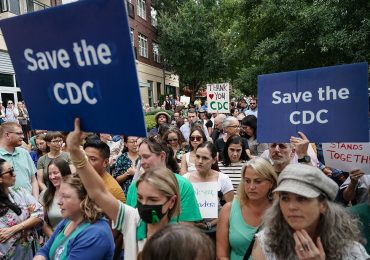By HOLLI BRADISH-LANE
I’ve seen clients start GLP-1 medications full of hope—and stop them feeling betrayed by their own biology.
Some reached their limit with side effects: relentless nausea, fatigue, or the quiet loss of joy in eating. Others simply couldn’t afford to stay on. A few never saw the promised results at all. But for nearly all of them, the story ended the same way—one step forward, five steps back.
We celebrate the success stories of GLP-1s, but we rarely talk about the crash that follows when treatment stops. And it’s not just psychological. The body rebounds fast—hunger, weight, and metabolic chaos rush back in.
The problem isn’t the medication itself. It’s that we’ve built an elegant on-ramp for GLP-1s—and almost no off-ramp at all.
The Evidence Is Already Warning Us
The data couldn’t be clearer. In the STEP-1 extension trial, participants who stopped semaglutide regained roughly two-thirds of the weight they had lost within one year. Their blood pressure, cholesterol, and blood-sugar levels slid back toward baseline.
A nearly identical pattern appeared in the SURMOUNT-4 trial for tirzepatide: those who continued therapy maintained—or even deepened—their weight loss; those who stopped rapidly regained.
Meanwhile, the SELECT cardiovascular outcomes trial showed semaglutide reduced major cardiac events in people with overweight and obesity. That’s a major win—but also a reminder that stopping abruptly can erase much of the benefit.
Both the American Diabetes Association 2025 Standards of Care and the American Gastroenterological Association guidelines now emphasize continuing anti-obesity pharmacotherapy beyond initial weight loss goals.
The implication is simple: for most patients, GLP-1s are not a 12-week intervention—they’re chronic therapy.
Yet in real life, chronic use isn’t always realistic.
Why So Many Will Stop Anyway
Insurance coverage ends. Supplies run short. A job changes, or a deductible resets. Some patients plan a pregnancy, experience intolerable side effects, or simply want to know who they are without the injection. Others plateau despite perfect adherence and feel the drug has stopped working.
In each case, the result is the same… withdrawal without a plan.
And what follows looks less like a gentle decline than a metabolic whiplash. Appetite returns fast—but satiety signals lag. Within weeks, the scale becomes a scoreboard of defeat, and shame creeps back in.
These are not failures of willpower. They’re failures of system design.
The Case for a GLP-1 Exit Plan
If we accept that many people will come off these medications, intentionally or not, then an Exit Plan must become a clinical standard of care.
A thoughtful off-ramp would include four essential pillars:
1. Tapering Instead of Termination
Formal tapering studies are limited, but real-world experience suggests that gradually reducing the dose helps blunt the rebound in hunger and nausea. It buys the brain and gut time to recalibrate. “Stop and hope” is not a strategy.
2. Lean-Mass Defense
Rapid weight loss on GLP-1s often includes muscle loss, which can impair long-term metabolic health. As dosing tapers, resistance training, adequate protein, and micronutrient-dense whole foods should become non-negotiable. These aren’t wellness trends—they’re biochemical stabilizers.
3. Glycemic and Hormonal Stability
Post-GLP-1 transitions can produce unpredictable glucose swings and hormonal shifts. Structured monitoring—fasting glucose, HbA1c, or continuous glucose data—can guide early intervention with metformin, micronutrient support, or dietary shifts.
4. Identity and Behavior Re-Engineering
GLP-1s don’t just quiet appetite– they quiet the reward loop tied to food. When that loop reawakens, people need new rituals, not shame. Behavioral scaffolding, mindset retraining, and sleep-stress alignment can make the difference between relapse and renewal.
In my own work, I call this the “after phase.” It’s where we teach the body and mind to cooperate again—to trust hunger, rebuild strength, and interpret cravings not as failure but as feedback.
Beyond Patients: A Systemic Challenge
Pharmaceutical innovation got us to the start line. Sustainability depends on how we design the finish.
If GLP-1s are chronic therapy, payers must step up and cover ongoing treatment or fund structured aftercare that protects the gains. Without that bridge, we create a revolving door—patients cycling through costly weight loss and inevitable regain, at the expense of both metabolic health and mental well-being.
If they’re time-limited interventions, clinicians must build exit protocols—just as they do for steroids, antidepressants, or insulin titrations. Medical care doesn’t stop when the prescription ends; it transitions. That same duty of continuity should apply here.
If they’re to become part of long-term public health strategy, policymakers must address affordability and access—not by rationing medications, but by supporting the infrastructure that keeps people well after they leave them. That means investing in nutrition literacy, behavior change coaching, and DNA-guided precision health approaches that reduce relapse risk.
This is not just about weight regain. It’s about metabolic resilience—helping people sustain lower inflammation, improved insulin sensitivity, and cardiovascular gains once pharmacologic scaffolding is removed. Without an exit framework, those hard-won improvements vanish, and the system pays again for complications that could have been prevented.
The opportunity is here, to treat GLP-1s not as a finish line, but as a phase within a continuum of care. Pharmaceutical innovation has rewritten what’s possible for weight loss. Now healthcare innovation must ensure that possibility endures.
And finally, patients must be invited into the conversation—not blamed for biology doing exactly what it’s designed to do. Empowered off-ramping isn’t indulgent, it’s essential to lasting health outcomes and fiscal responsibility alike.
The Real Measure of Success
The question isn’t whether GLP-1s “work.” They clearly do—while they’re in use. The real question is whether our healthcare system can support the “after”. Because success isn’t just what happens on the medication. It’s who a person becomes when they step off it.
Holli Bradish-Lane is the founder of Iron Crucible Health Coaching and the Crucible Center for Arts and Wellbeing in Colorado. She is the author of The GLP-1 Exit Plan
Leave a comment





